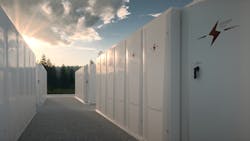DOE Secretary Announces Goal to Cut Costs of Long-Duration Energy Storage by 90%
U.S. Secretary of Energy Jennifer M. Granholm recently announced the U.S. Department of Energy's (DOE's) new goal to reduce the cost of grid-scale, long-duration energy storage by 90% within the decade. The second target within the DOE's Energy Earthshot Initiative, Long Duration Storage Shot (LDSS), sets bold goals to accelerate breakthroughs that store clean electricity to make it available anytime, anywhere, and support more abundant, affordable, and reliable clean energy solutions.
"We're going to bring hundreds of gigawatts of clean energy onto the grid over the next few years and we need to be able to use that energy wherever and whenever needed," said Granholm. "That's why the DOE is working aggressively toward cheaper, longer-duration energy storage to reach President Biden's goal of 100% clean electricity by 2035. This new initiative will create new manufacturing jobs right here at home and make sure clean, reliable, affordable electricity is available to everyone, including Americans living in remote and underserved communities."
Long-duration energy storage — defined as systems that can store energy for more than 10 hours at a time — would support a low-cost, reliable, carbon-free electric grid. Cheaper and more efficient storage will make it easier to capture and store clean energy for use when energy generation is unavailable or lower than demand — for instance, so solar-generated power can be used at night or nuclear energy generated during times of low demand can be used when demand increases.
Developing the technology and manufacturing to reach the LDSS cost targets will also establish a new, U.S.-based manufacturing industry and union jobs for storage products. Energy storage can also increase local control of the power system and build resilience for communities, including by minimizing power grid disruptions.
"Energy storage technology holds great promise in the fight against climate change. Strengthening current technology and advancing next-generation energy storage will allow us to integrate more renewables, such as wind and solar, which in turn will help to reduce emissions," said U.S. Senator Susan Collins. "That's why I authored the Better Energy Storage Technology Act, which seeks to align U.S. research efforts to promote advancements in energy storage technologies. It is exciting to see the DOE begin implementing this new law through this initiative to substantially reduce the cost of energy storage technologies, improve the efficiency of our nation's electricity grid, and bring us closer to a clean energy future."
"Long-duration energy storage is the key that unlocks our clean energy future," said U.S. Senator Angus King. "In recent years, we've seen massive advances in renewable technologies, but the challenge remains: how do we power the grid when the wind stops blowing or the sun doesn't shine? Cost-effective, energy-efficient storage systems will solve this problem and help ensure that the power generated during periods of low demand can be captured for moments of peak use. This investment is a critical step for our efforts to advance America's technological leadership in this key field and confront climate change."
The LDSS will consider all types of technologies — whether electrochemical, mechanical, thermal, chemical carriers, or any combination that has the potential to meet the necessary duration and cost targets for grid flexibility. Currently, pumped-storage hydropower is the largest source of long-duration energy storage on the grid and lithium ion is the primary source of new energy storage technology deployed on the grid in the United States, providing shorter duration storage capabilities.
The DOE developed the LDSS target through its crosscutting Energy Storage Grand Challenge (ESGC) and wide-reaching stakeholder engagement activities and input from subject matter experts. It will continue concerted outreach to advance the LDSS and the ESGC's aggressive goals and strategy.
The ESGC and the LDSS are linked with integrated efforts across the Department's Offices of Energy Efficiency and Renewable Energy, Electricity, Fossil Energy and Carbon Management, Science, Nuclear Energy, and Technology Transitions, as well as the Advanced Research Projects Agency — Energy.
